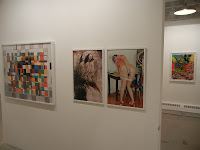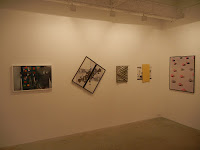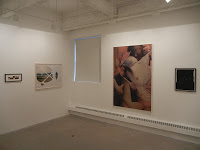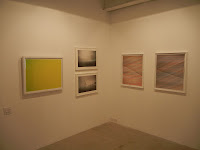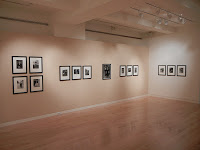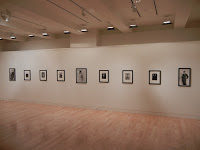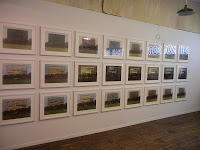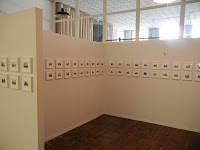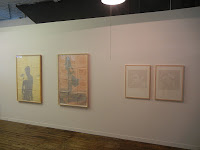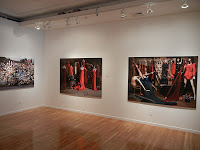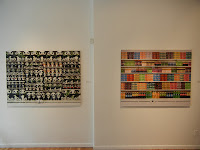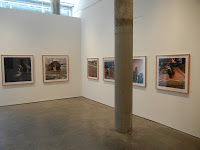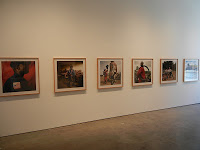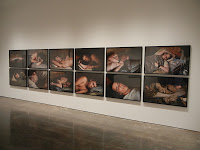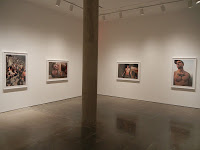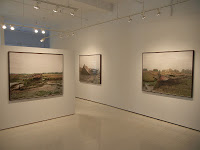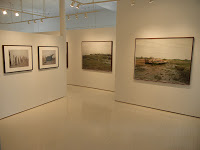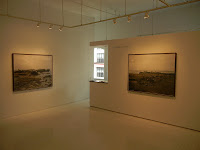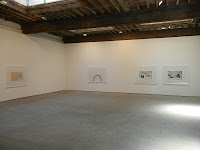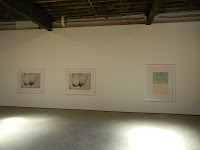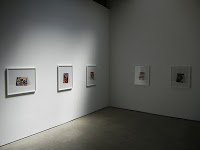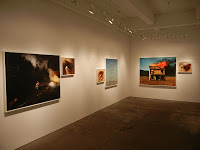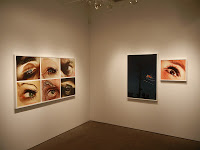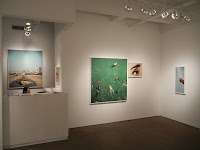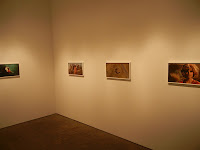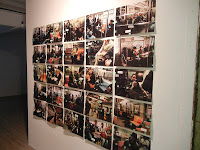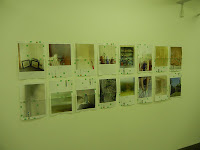 JTF (just the facts): A total of 210 photographs, films, and photobooks, from 80 different photographers/artists, variously framed and matted, and hung in a series of connecting rooms on the third floor of the museum. The works span the period from 1910 to 2009, and are drawn the museum’s permanent collection of photography. The exhibit was curated by Roxana Marcoci. (Installation shots at right.)
JTF (just the facts): A total of 210 photographs, films, and photobooks, from 80 different photographers/artists, variously framed and matted, and hung in a series of connecting rooms on the third floor of the museum. The works span the period from 1910 to 2009, and are drawn the museum’s permanent collection of photography. The exhibit was curated by Roxana Marcoci. (Installation shots at right.)
In each room, a list of photographers with work on view is provided, with the number of photographs/films/books and image/publication dates in each in parentheses:
Gallery 1
Man Ray (5 gelatin silver prints, 4 photogravures, 1 book and 1 film, 1922, 1923, 1924, 1927, 1931)
Paul Eluard and Man Ray (1 book, 1935)
Laszlo Moholy-Nagy (5 gelatin silver prints and 1 film, 1923-1925, 1925, 1926, 1930)
Florence Henri (1 gelatin silver print, 1928)
Paul Strand and Charles Sheeler (1 film, 1921)
Edward Steichen (1 gelatin silver print, 1932)
Berenice Abbott (1 gelatin silver print, 1935)
Charles Sheeler (1 gelatin silver print, 1927/1941)
Paul Strand (1 photogravure, 1916)
Alfred Stieglitz (1 gelatin silver print, 1910)
.
 Gallery 2
Gallery 2
Herbert Bayer (1 gelatin silver print, 1928)
Florence Henri (1 gelatin silver print, 1937)
El Lissitzky (1 gelatin silver print, 1 book and 2 magazines, 1924, 1928, 1929)
Paul Citroen (1 gelatin silver print and 1 book, 1923, 1927)
Aleksandr Rodchenko (7 gelatin silver prints and 12 magazines, 1923, 1924, 1926, 1927, 1928, 1928-1930, 1930)
Gustav Klutsis, Aleksandr Rodchenko, and Sergei Senkin (1 magazine, 1924)
Gustav Klutsis (1 magazine, 1931)
Solomon Telingater (1 magazine, 1931)
Dziga Vertov (1 gelatin silver print and 1 film, 1929, 1930)
Walker Evans (1 gelatin silver print and 1 book, 1936, 1938)
Henri Cartier-Bresson (1 gelatin silver print and 1 book, 1933/1968, 1952)
Tina Modotti (1 gelatin silver print, 1928)
Claude Cahun (1 gelatin silver print, 1928)
Andre Kertesz (2 gelatin silver prints, 1929, 1933)
Horst P. Horst (1 gelatin silver print, 1939)
Jan Lukas (1 gelatin silver print, 1933)
Hans Bellmer (1 gelatin silver print and 3 books, 1934, 1935-1937, 1936, 1949)
Grete Stern (1 gelatin silver print, 1949)
Georges Hugnet (1 collage, 1935)
 Imogen Cunningham (1 gelatin silver print, 1932)
Imogen Cunningham (1 gelatin silver print, 1932)
Edward Weston (1 palladium or platinum print, 1925)
Man Ray (1 gelatin silver print and 1 book, 1924, 1927)
Unknown (1 gelatin silver print, 1921)
Jacques-Andre Boiffard (2 books, 1929, 1930)
Germaine Krull (1 gelatin silver print and 1 book, 1927, 1929)
Albert Renger-Patzsch (1 gelatin silver print and 1 book, 1928, 1930)
August Sander (2 gelatin silver prints and 1 book, 1928, 1929)
Max Burchartz (1 gelatin silver print, 1928)
Josef Albers (1 set of 12 gelatin silver prints, 1931)
Umbo (1 gelatin silver print, 1927)
Raoul Hausmann (1 gelatin silver print, 1931)
Berenice Abbott (1 gelatin silver print, 1930/1950)
Maurice Tabard (1 gelatin silver print, 1929)
John Heartfield (1 gravure, 1932)
Laszlo Moholy-Nagy (2 photomontages, 1925)
Gallery 3 (small side room)
Gerhard Ruhm (1 set of 17 photomontages/text, 1959)
 Gallery 3
Gallery 3
Lee Friedlander (21 gelatin silver prints, 1979, 1981, 1982, 1983, 1985, 1986, 1987)
Helen Levitt (40 color slides in projection, 1971-1974)
Michael Schmidt (4 gelatin silver prints, 1965-1967)
Kikuji Kawada (1 gelatin silver print, 1960-1965)
Daido Moriyama (1 gelatin silver print and 1 book, 1967, 1968)
Tetsuya Ichimura (1 gelatin silver print, 1964)
Ryoji Akiyama (1 gelatin silver print, 1970)
Shomei Tomatsu (1 gelatin silver print and 1 book, 1961, 1966)
Robert Frank (2 gelatin silver prints and 2 books, 1955, 1956, 1959)
William Klein (1 gelatin silver print and 1 book, 1955, 1956)
Harry Callahan (1 gelatin silver print, 1959)
Roy DeCarava (1 gelatin silver print, 1952)
Dorothea Lange (1 gelatin silver print, 1957)
Garry Winogrand (2 gelatin silver prints, 1969)
Diane Arbus (1 gelatin silver print, 1967)
Richard Avedon (1 set of gelatin silver prints, 1971)
Gallery 4A
Valie Export (2 gelatin silver prints with ink, 1972, 1976)
Mel Bochner (1 set of cards/envelope, 1970)
Eleanor Antin (1 set of postcards, 1971-1973)
On Kawara (3 sets of postcards, 1977)
Stephen Shore (9 postcards and 1 chromogenic print, 1972, 1973/2002)
William Eggleston (1 dye transfer print, 1969)
 Robert Adams (6 gelatin silver prints, 1968, 1969, 1970)
Robert Adams (6 gelatin silver prints, 1968, 1969, 1970)
Bernd and Hilla Becher (2 gelatin silver prints, 1970, 1982)
Joel Sternfeld (1 chromogenic print, 1979/1987)
Ed Ruscha (15 books, 1963, 1965, 1966, 1967, 1968)
John Baldessari (1 set of gelatin silver prints with oil tint and polymer paint, 1986)
Gordon Matta-Clark (1 silver dye bleach print and 1 film, 1974, 1978)
Gallery 4B
Robert Heinecken (6 silver dye bleach prints, 1988)
Philip-Lorca diCorcia (2 chromogenic prints, 1990-1992)
Martha Rosler (12 pigmented inkjet prints, 1967-1972/2011)
Sigmar Polke (9 gelatin silver prints with applied color, 1970, 1971, 1973, 1975)
Gallery 5
The Atlas Group/Walid Raad (1 set of 100 pigmented inkjet prints, 1996-2004)
Paul Graham (1 set of 6 pigmented inkjet prints and 1 book, 2004/2008, 2007)
Carter Mull (1 chromogenic color print with pasted chromogenic color print, 2009)
Joann Verburg (1 set of 2 chromogenic color prints, 1991)
Jules Spinatsch (1 pigmented inkjet print and 3 videos, 2003)
Harrell Fletcher (7 sets of pigmented inkjet prints, 2005)
.
 Comments/Context: With the job of head photography curator currently vacant, this year’s annual rehanging of the permanent collection of photography at MoMA marks a period with the team in transition. In the past, this show was the work of the curators as a group and had a more institutional point of view, but in recent years, the rehang has been given a more personal feel under the hand of a single curator. This year’s effort has been organized by Roxana Marcoci, and its thematic construct tilts away from a traditional history of the medium, taking a more anti-establishment view of the progression of artistic ideas. Instead of a parade of beloved and easily recognizable photographic masterworks, this exhibit follows the path of avant-garde and experimental movements of various kinds, tracing lines of criticism, dissent, and rejection of the mainstream. It’s a more radical history than we’re used to, riskier and less obvious than the one we all carry around in our heads.
Comments/Context: With the job of head photography curator currently vacant, this year’s annual rehanging of the permanent collection of photography at MoMA marks a period with the team in transition. In the past, this show was the work of the curators as a group and had a more institutional point of view, but in recent years, the rehang has been given a more personal feel under the hand of a single curator. This year’s effort has been organized by Roxana Marcoci, and its thematic construct tilts away from a traditional history of the medium, taking a more anti-establishment view of the progression of artistic ideas. Instead of a parade of beloved and easily recognizable photographic masterworks, this exhibit follows the path of avant-garde and experimental movements of various kinds, tracing lines of criticism, dissent, and rejection of the mainstream. It’s a more radical history than we’re used to, riskier and less obvious than the one we all carry around in our heads.
The kind of vanguardism that Marcoci is interested in doesn’t really begin until the early 1900s, so the entire 19th century is thrown overboard here. The story starts with Man Ray and Dada, Moholy-Nagy and the Bauhaus, and a handful of images awash in the glory of skyscrapers and industry. The playfulness of Many Ray’s rayographs is juxtaposed with the intellectual rigor and sobriety of Moholy-Nagy’s photographs and still lifes, and Steichen and Sheeler carry the banner of Modernism. Each mini-section is puctuated by a film, making the differences in vision more clear; Moholy-Nagy’s A Lightplay, Black White Gray is a mesmerizing onslaught of rotating, shifting, abstract forms and interplays of light, while Sheeler and Strand’s Manhatta captures the frenetic pace of the city.
 The next room continues the between the wars theme with samples of Constructivism, Surrealism, and works from the New Objectivity movement. An entire wall is devoted to images by Rodchenko, offset by examples of letterpress pamphlets and magazines using many of the same images combined with vivid typography and graphic design. Surrealism is led by Bellmer and Kertesz, with an additional dividing wall covered with distorted eyes and faces. Krull, Renger-Patzsch and Sander make up the short history of New Objectivity (where is Blossfeldt?), matched by iconic photobooks from each, including Krull’s geometric masterpiece Metal.
The next room continues the between the wars theme with samples of Constructivism, Surrealism, and works from the New Objectivity movement. An entire wall is devoted to images by Rodchenko, offset by examples of letterpress pamphlets and magazines using many of the same images combined with vivid typography and graphic design. Surrealism is led by Bellmer and Kertesz, with an additional dividing wall covered with distorted eyes and faces. Krull, Renger-Patzsch and Sander make up the short history of New Objectivity (where is Blossfeldt?), matched by iconic photobooks from each, including Krull’s geometric masterpiece Metal.
As we cross into the 1950’s, the named artistic movements start to disappear, and the definition of the avant-garde starts to shift. As a result, the narrative of this show becomes more diffuse, with individually driven social and political criticism coming to the forefront a bit more. A small selection of gritty Japanese works (both photographs and books from the likes of Moriyama, Tomatsu and others) is well-paired with Michael Schmidt from Germany (an excellent choice) and Frank, Klein and Arbus from America, as they all developed unique and ultimately influential visual vocabularies. The rest of the room felt less in line with the “new visions” construct, especially the out of chronological order Friedlanders from the 1980s.
 Moving into the 1970s in the next room, Conceptual photography takes the lead, followed closely by the New Topographics and the emergence of American color. Books, postcards, and other materials are seamlessly merged with the photographs, giving Bochner, Kawara, and Ruscha appropriately equal footing with the likes of the Bechers, Robert Adams, and Matta-Clark. The entire corner containing Valie Export’s body configurations, Eleanor Antin’s lines of rubber boots, and Stephen Shore’s dull small town postcards is particularly strong.
Moving into the 1970s in the next room, Conceptual photography takes the lead, followed closely by the New Topographics and the emergence of American color. Books, postcards, and other materials are seamlessly merged with the photographs, giving Bochner, Kawara, and Ruscha appropriately equal footing with the likes of the Bechers, Robert Adams, and Matta-Clark. The entire corner containing Valie Export’s body configurations, Eleanor Antin’s lines of rubber boots, and Stephen Shore’s dull small town postcards is particularly strong.
As is often the case in these historical summary shows, when we reach the 1980s and beyond, the prints and the series projects get physically larger, so less diversity tends to get shown in the last few rooms. This is a real problem, as complex trends get boiled down to a small number of not necessarily representative works. In a room meant to encompass the 1980s and 1990s, we have a group of 1970s experimental works by Polke, a series of Martha Rosler’s Vietnam war-charged collages (also from the 1970s), a group of Heinecken’s magazine composites, and a pair of diCorcia portraits. All of these work inside the construct of opposition to mainstream cultural values and the creation of new aesthetics. I’m just not convinced however that these four adequately tell the entire story of changes that were going on during that twenty year period. As an example, while we might argue about whether the Dusseldorf school was avant-garde enough or not in this definition, it was undeniably an influential movement/vision and leaving it out altogether seems puzzling. Perhaps we’re just back to small rooms that won’t hold all the pictures we might like to see.
 The final room highlights new visual motifs from Graham’s time-lapsed series work to Walid Raad’s exploration of archival material (car bombs). Given the newness of the work here, the vanguardism and eventual downstream influence is less clear, although all of the pieces have an angle of social or political commentary. Whether these disparate themes congeal into nameable historical movements is too early to tell, but experimental questioning in all its forms is still very much alive and well.
The final room highlights new visual motifs from Graham’s time-lapsed series work to Walid Raad’s exploration of archival material (car bombs). Given the newness of the work here, the vanguardism and eventual downstream influence is less clear, although all of the pieces have an angle of social or political commentary. Whether these disparate themes congeal into nameable historical movements is too early to tell, but experimental questioning in all its forms is still very much alive and well.
In general, I like the fact that the MoMA is offering alternative views of history for us to examine and evaluate; we’d be bored by the same old anointing of champions. But if you’re looking for Ansel Adams, Edward Weston, Irving Penn, or many other household names, this show will both sorely disappoint you and perhaps open your eyes to some new perspectives. While its overarching scholarly theme gets stretched thin in places, the exhibit does provide a coherent outline of the development of avant-garde ideas in photography and their ongoing and continued relevance to the evolution of the medium. The story peters out a bit toward the end, but that may have more to do with the ever changing definitions of what is in and outside the mainstream and the atomisation of trends, than with any lack of pushing the edges of the artistic envelope.
 Collector’s POV: Given this is a broad museum show, there are, of course, no posted prices, and with such a wide range of work on view, we’ll pass on the usual secondary market analysis for this exhibition.
Collector’s POV: Given this is a broad museum show, there are, of course, no posted prices, and with such a wide range of work on view, we’ll pass on the usual secondary market analysis for this exhibition.
.
Rating: ** (two stars) VERY GOOD (rating system described here)
Transit Hub:
- Previous permanent collection installations: 2011 (here), 2010 (here), 2009 (here), 2008 (here)
The Shaping of New Visions: Photography, Film, Photobook
Through April 29th (2013)
Museum of Modern Art
11 West 53rd Street
New York, NY 10019
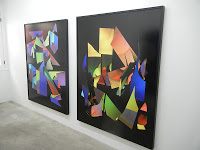 JTF (just the facts): A total of 3 large scale color photographs, framed in black and unmatted, and hung in the small single room gallery space. All of the works are archival inkjet prints, made in 2012. Each is sized roughly 73×57, and available in editions of 3. (Installation shots at right.)
JTF (just the facts): A total of 3 large scale color photographs, framed in black and unmatted, and hung in the small single room gallery space. All of the works are archival inkjet prints, made in 2012. Each is sized roughly 73×57, and available in editions of 3. (Installation shots at right.)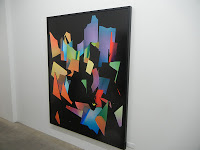 I like the idea of moving back and forth between studio reality and abstraction, and being allowed to explore the assembled world in multiple ways, where figure and ground alternation shift to the investigation of a turned mirror or a curve of shadow, and back again. Labatte proves there is plenty of unexamined territory in the still life genre, especially when complicated, made-to-be-photographed constructions are used to create nuanced illusions. While there are only three pictures in this tiny show, they offer plenty of excellent opportunities to get lost in the details.
I like the idea of moving back and forth between studio reality and abstraction, and being allowed to explore the assembled world in multiple ways, where figure and ground alternation shift to the investigation of a turned mirror or a curve of shadow, and back again. Labatte proves there is plenty of unexamined territory in the still life genre, especially when complicated, made-to-be-photographed constructions are used to create nuanced illusions. While there are only three pictures in this tiny show, they offer plenty of excellent opportunities to get lost in the details. JTF (just the facts): A total of 210 photographs, films, and photobooks, from 80 different photographers/artists, variously framed and matted, and hung in a series of connecting rooms on the third floor of the museum. The works span the period from 1910 to 2009, and are drawn the museum’s permanent collection of photography. The exhibit was curated by Roxana Marcoci. (Installation shots at right.)
JTF (just the facts): A total of 210 photographs, films, and photobooks, from 80 different photographers/artists, variously framed and matted, and hung in a series of connecting rooms on the third floor of the museum. The works span the period from 1910 to 2009, and are drawn the museum’s permanent collection of photography. The exhibit was curated by Roxana Marcoci. (Installation shots at right.) Gallery 2
Gallery 2 Imogen Cunningham (1 gelatin silver print, 1932)
Imogen Cunningham (1 gelatin silver print, 1932) Gallery 3
Gallery 3 Robert Adams (6 gelatin silver prints, 1968, 1969, 1970)
Robert Adams (6 gelatin silver prints, 1968, 1969, 1970) Comments/Context: With the job of head photography curator currently vacant, this year’s annual rehanging of the permanent collection of photography at MoMA marks a period with the team in transition. In the past, this show was the work of the curators as a group and had a more institutional point of view, but in recent years, the rehang has been given a more personal feel under the hand of a single curator. This year’s effort has been organized by Roxana Marcoci, and its thematic construct tilts away from a traditional history of the medium, taking a more anti-establishment view of the progression of artistic ideas. Instead of a parade of beloved and easily recognizable photographic masterworks, this exhibit follows the path of avant-garde and experimental movements of various kinds, tracing lines of criticism, dissent, and rejection of the mainstream. It’s a more radical history than we’re used to, riskier and less obvious than the one we all carry around in our heads.
Comments/Context: With the job of head photography curator currently vacant, this year’s annual rehanging of the permanent collection of photography at MoMA marks a period with the team in transition. In the past, this show was the work of the curators as a group and had a more institutional point of view, but in recent years, the rehang has been given a more personal feel under the hand of a single curator. This year’s effort has been organized by Roxana Marcoci, and its thematic construct tilts away from a traditional history of the medium, taking a more anti-establishment view of the progression of artistic ideas. Instead of a parade of beloved and easily recognizable photographic masterworks, this exhibit follows the path of avant-garde and experimental movements of various kinds, tracing lines of criticism, dissent, and rejection of the mainstream. It’s a more radical history than we’re used to, riskier and less obvious than the one we all carry around in our heads. The next room continues the between the wars theme with samples of Constructivism, Surrealism, and works from the New Objectivity movement. An entire wall is devoted to images by Rodchenko, offset by examples of letterpress pamphlets and magazines using many of the same images combined with vivid typography and graphic design. Surrealism is led by Bellmer and Kertesz, with an additional dividing wall covered with distorted eyes and faces. Krull, Renger-Patzsch and Sander make up the short history of New Objectivity (where is Blossfeldt?), matched by iconic photobooks from each, including Krull’s geometric masterpiece Metal.
The next room continues the between the wars theme with samples of Constructivism, Surrealism, and works from the New Objectivity movement. An entire wall is devoted to images by Rodchenko, offset by examples of letterpress pamphlets and magazines using many of the same images combined with vivid typography and graphic design. Surrealism is led by Bellmer and Kertesz, with an additional dividing wall covered with distorted eyes and faces. Krull, Renger-Patzsch and Sander make up the short history of New Objectivity (where is Blossfeldt?), matched by iconic photobooks from each, including Krull’s geometric masterpiece Metal. Moving into the 1970s in the next room, Conceptual photography takes the lead, followed closely by the New Topographics and the emergence of American color. Books, postcards, and other materials are seamlessly merged with the photographs, giving Bochner, Kawara, and Ruscha appropriately equal footing with the likes of the Bechers, Robert Adams, and Matta-Clark. The entire corner containing Valie Export’s body configurations, Eleanor Antin’s lines of rubber boots, and Stephen Shore’s dull small town postcards is particularly strong.
Moving into the 1970s in the next room, Conceptual photography takes the lead, followed closely by the New Topographics and the emergence of American color. Books, postcards, and other materials are seamlessly merged with the photographs, giving Bochner, Kawara, and Ruscha appropriately equal footing with the likes of the Bechers, Robert Adams, and Matta-Clark. The entire corner containing Valie Export’s body configurations, Eleanor Antin’s lines of rubber boots, and Stephen Shore’s dull small town postcards is particularly strong. The final room highlights new visual motifs from Graham’s time-lapsed series work to Walid Raad’s exploration of archival material (car bombs). Given the newness of the work here, the vanguardism and eventual downstream influence is less clear, although all of the pieces have an angle of social or political commentary. Whether these disparate themes congeal into nameable historical movements is too early to tell, but experimental questioning in all its forms is still very much alive and well.
The final room highlights new visual motifs from Graham’s time-lapsed series work to Walid Raad’s exploration of archival material (car bombs). Given the newness of the work here, the vanguardism and eventual downstream influence is less clear, although all of the pieces have an angle of social or political commentary. Whether these disparate themes congeal into nameable historical movements is too early to tell, but experimental questioning in all its forms is still very much alive and well. Collector’s POV: Given this is a broad museum show, there are, of course, no posted prices, and with such a wide range of work on view, we’ll pass on the usual secondary market analysis for this exhibition.
Collector’s POV: Given this is a broad museum show, there are, of course, no posted prices, and with such a wide range of work on view, we’ll pass on the usual secondary market analysis for this exhibition.